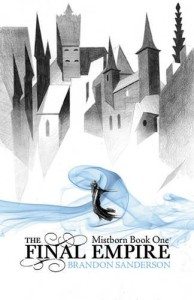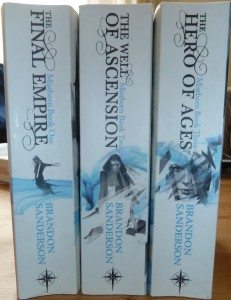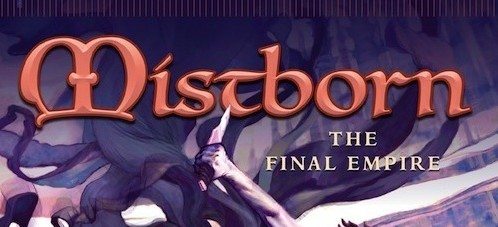Forays into Fantasy: ‘The Final Empire’ by Brandon Sanderson (Review)
[dropcap]A[/dropcap]ny connoisseur of fantasy fiction will be hard-pressed these days to peruse a bookshelf without stumbling across one of Brandon Sanderson’s many novels. Having become a big name churning out chunky books about obligatorily hooded characters saving the world, the majority of his success derives from his Mistborn trilogy, which became a US bestseller, and … well, that counts for a lot.
I stumbled upon The Final Empire, the first book of Mistborn, the way I usually do with fantasy novels, by rifling through second-hand book shops. Spine: well-worn. Good start, the previous owner had at least suffered through to the end. Cover art: intriguing, depicting a spired, dystopian capital in charcoal. Then the slogan skimmed across my line of vision.
What if the Dark Lord won?
Oh, and it was going so well, this brief love affair. ‘Dark Lord’ was printed in bold, as if my eyes needed more rolling momentum. My absolute bugbear, one of the great clichés of fantasy fiction, on display.
I still bought the book; twenty-five pence later, I had reservations I might not have bought much, but it should at least keep me entertained. After that it was laid down under a long reading list, to gather dust for a few years, until I found it again this summer and decided to stop being so snooty about it all and just give it a go.
 The Final Empire revolves around the Skaa, a race of slaves, subjugated by an aristocratic hierarchy, and their hopeless endeavours to overthrow the immortal Lord Ruler, a being raised to the status of a god. For a thousand years he has reigned, commanding some truly terrifying creatures, the Steel Inquisitors, to do his bidding. After such a time, the Skaa population, having lost so much in battles for freedom, are now conquered in the sense that most matters – the emotional sense. Enter Kelsier, a Mistborn (one who can command metals by burning to gain powerful abilities through the use of Allomancy) who has not yet lost the courage to summon a rebellion. Along with Vin, a member of a thieving crew, and a team of Mistings, he sets about to bring the Lord Ruler’s control to its end.
The Final Empire revolves around the Skaa, a race of slaves, subjugated by an aristocratic hierarchy, and their hopeless endeavours to overthrow the immortal Lord Ruler, a being raised to the status of a god. For a thousand years he has reigned, commanding some truly terrifying creatures, the Steel Inquisitors, to do his bidding. After such a time, the Skaa population, having lost so much in battles for freedom, are now conquered in the sense that most matters – the emotional sense. Enter Kelsier, a Mistborn (one who can command metals by burning to gain powerful abilities through the use of Allomancy) who has not yet lost the courage to summon a rebellion. Along with Vin, a member of a thieving crew, and a team of Mistings, he sets about to bring the Lord Ruler’s control to its end.
The premise starts off promising. Laid out bare is an established caste system, oppresses masses filling the bottom, aristocratic, privileged few balancing on top, but even more pleasing is to see Sanderson very early do away with clean-cut white good and black evil, in favour of tipping the scales of his caste. While he doesn’t summon entire factions of Skaa with questionable motives or clean-sleeved noblemen, the few characters who do surpass the reader’s expectations are often major ones and contribute greatly to the overall spin of the tale, making for a few surprising and refreshing twists. In the novel’s climax, an unexpected frenzy of events that will blow how you thought the first book would end completely out of the water. If at no other point in the novel The Final Empire grabs you by its hooks, it will definitely be doing so if you make it to page five hundred. But then, that’s an awful lot of pages to read just to reach the juicy bit, isn’t it?
Here is where The Final Empire reaches a stone wall, one that even Sanderson’s Allomancers can’t scale.
Too much fantasy is replaced by slavery from page one to five hundred. Skaa are depressed, cowardly people, superstitious and primitive by the aristocracy’s standards. Most display little in the way of individual character, even those who are protagonists. Sanderson also throws in a coarse and needless sexual exploitation of Skaa women in the prologue, just to demonstrate how evil the plantation aristocrat really is, in case you didn’t already know that by his owning, beating and starving a bunch of slaves. It’s a shame that Sanderson resorts to rape for the sake of rape, when the book is better than this nonsensical vulgarity. And at the end of the day, it all feels a bit too… our-worldy. When I peel back a fantasy cover, I want intrigue, suspense, marvellous ideas – instead, with The Final Empire you get a re-working of the Atlantic slave trade with a bit of metal thrown in.
 That ‘bit of metal’ also causes some large narrative problems. On the surface, Allomancy is an intriguing fantasy ability, established thoroughly with its own limitations. Some allomancers can use all metals, others are experts in one, and each metal has a different purpose, pushing and pulling using a ying-yang philosophy. Despite the author having clearly fleshed out Mistborn powers over the course of many months to give it the depth we see in the final product, it is an ability that is fatally flawed at its core, relying too heavily on the act of burning metal to trigger it.
That ‘bit of metal’ also causes some large narrative problems. On the surface, Allomancy is an intriguing fantasy ability, established thoroughly with its own limitations. Some allomancers can use all metals, others are experts in one, and each metal has a different purpose, pushing and pulling using a ying-yang philosophy. Despite the author having clearly fleshed out Mistborn powers over the course of many months to give it the depth we see in the final product, it is an ability that is fatally flawed at its core, relying too heavily on the act of burning metal to trigger it.
Narrative descriptions, especially in fight sequences, soon become repetitive and dull because so many lines are allotted to repeating ‘Kelsier burned [said metal]’ each time he throws a body across the room – which is a lot of the time. While I understand Sanderson cannot vary these sentences much, it becomes increasingly obvious that with Allomancy he has backed himself into the narrative corner. There is no room for movement, and you soon find yourself skimming paragraphs where things are actually happening just to avoid the word ‘flare,’ which you must have read a thousand times already.
A reviewer for the Washington Post said of Allomancy ‘[it] sometimes feels a little like a video game trick (press X-Y-X-X to burn steel!)’ and I’m inclined to agree. Some of Sanderson’s sentences can be messy at best, but Allomancy brings a whole new level of clumsiness to the narrative that saps the pace of battles and could only be bypassed if the idea of burning metals was done away with completely.
But then it wouldn’t be Allomancy would it? Whoops…
So now this world’s ‘magic’ has fallen like a house of cards, surely there is nothing left to find lacking. Actually… there’s Vin, our female street rat protagonist, and – you guessed it – an orphan. I’m starting to think all fantasy writers were beaten as children to have such a grudge against parents. As leading lady, Vin rarely falls short of defying rationality. She has lived in a world of terrors, been preyed on by men and beaten by her brother, Reen, while living beneath the iron fists of the Lord Ruler and the
aristocracy. Naturally, she ought to despise them and all they stand for, yet when she is called on by Kelsier to train as a lady to infiltrate the aristocracy, Vin’s main concerns become how beautiful her dresses look, how wonderful everybody dances and how much she adores balls. It feels as though, in two pages flat, Vin turns from an independent young woman into a vapid little girl and this transformation comes with its own dying narrative moments. Seeing fit to describe everything which excites her, Vin subjected me to countless descriptions of each house’s rafters, galleries, balconies and coloured glass windows. My inner monologue soon started asking, ‘Why do I need to know this?’
Far from reaching her potential, Vin, a heroine who ought to have been steadfast, is uncharacteristically sucked into the aristocratic world without reason. This made me as irritated as when I read Throne of Glass, which is all about an assassin who spends three hundred pages admiring the silk frills on her dresses. Women in fantasy should not always conform to this crude, girlish stereotype, and I found it thoroughly disappointing that Vin’s promising character was cheapened in such a way.
conform to this crude, girlish stereotype, and I found it thoroughly disappointing that Vin’s promising character was cheapened in such a way.
After pointing out The Final Empire’s many crooked features, it might come as a surprise that I still enjoyed reading it. True, the story is contrived at times, truer still, it falls hard for clichés, but despite this, it also tries to challenge the conventions of modern fantasy in its own way. You will find no mention of dragons here, no elves or goblins, and this relief from Tolkien-lite creates a world that is, though less fantastical than you might wish, undoubtedly a more inspired and original world than most. Allomancy is an untidy ability, but push past its narrative problems and you’ll discover a truly unique power beneath. Sanderson ultimately dives deep into the concept of slavery to muster a dark and dire concept that is as imaginatively dystopian as it is illustrative of past events in our own world history.
Perhaps, in the end, I liked The Final Empire because of its somewhat fresh take on fantasy, or it has just been so long since I’ve read a fantasy I would have devoured anything with swiggly writing on the cover. I hope it’s not the latter, because I’ve still two books to go…
[divider]

Comments (1)
“Sanderson also throws in a coarse and needless sexual exploitation of Skaa women in the prologue, just to demonstrate how evil the plantation aristocrat really is, in case you didn’t already know that by his owning, beating and starving a bunch of slaves. It’s a shame that Sanderson resorts to rape for the sake of rape, when the book is better than this nonsensical vulgarity.”
*SPOILERS FOLLOW*
That was foreshadowing, not base sensuality.
There is a difference of narrative necessity to explain a plot point, and an author just throwing in sex, rape, etc. to be lewd
Brandon wasn’t simply looking for vulgarity or cheap sensuality. Its a huge plot point in the books that that mistborns that are a threat to the Empire (born of the nobility AND Skaa) are something the Lord Ruler wishes to prevent so he can control the variables. He’s messed with all humans’ DNA do as to manipulate them better, to do his best to ensure humanity survives with the (now spent) power of the Well of Ascention.
The LR is attempting to make sure Ruin (a deity of sorts bent on world destruction) cannot escape, and prevent the end of the world, as only a mistborn not under his thumb can release Ruin from his prison.
So bc any threat to the empire (mistborns he cannot control) are threat to the survival of humanity (in his view) all skaa who have sex with nobility are to be put to death so as to avoid the variable of rebellious mistborns to the equation .
After computing all the potential variables with what knowledge he had, after he’d spent the power of the Well of Ascention, a huge threat to humanity were mistborns.
Also, this scene forshadows how Vin was conceived, and why the LR is so strict on it, as he was right, a mistborn killed him and released Ruin in ignorance.
Vin’s choices and the rest of the cast releases Ruin and destroys their world as they know it in the battle against Ruin.
Point being, foreshadow of a huge plot point, not “unnecessary” lewdness…